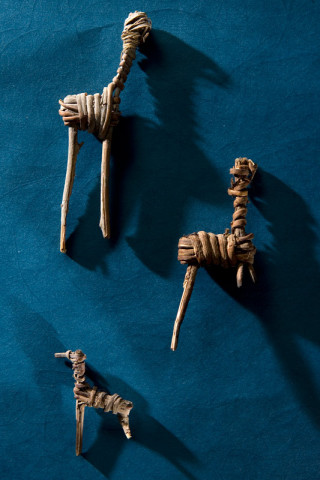Explorer Corps Marker: Wayne County
Find the Marker
The Wayne County marker is at the Wayne County Information Center at the junction of highways 12 and 24 in Torrey, Utah. The marker highlights Cowboy Cave, located on ancestral lands of the Ute Tribe and situated along a tributary of the Green River in southeastern Utah.
GPS 38°17’54.2256”N 111°24’6.3036”W
Dig Deeper
Piecing together the history of Utah’s past isn’t an easy task. Cowboy Cave, in Wayne County, is an example of the challenge. Located on the ancestral lands of the Ute Tribe along a tributary of the Green River, Cowboy Cave records thousands of years of history.

The initial studies of Cowboy Cave go back to 1975. University of Utah archaeologist Jesse Jennings, NHMU's founding director, excavated the site and suspected that people inhabited and used to cave 9,000 years ago. But the cave layers were hard to understand. The layers of the cave with cultural artifacts seemed to be interspersed with layers that didn’t have anything at all, leading Jennings to suggest that the cave was inhabited and abandoned over and over again over time.
Later studies came up with different theories. Examinations of the cave during the 1990s led archaeologists to propose that the earliest habitation of the cave was 8,000 years ago. That figure changed again in 2006, when archaeologists found a basket sticking up from the floor of the cave that could be dated to 9,000 years ago. With the new evidence, archaeologists concluded, Jennings’ original idea was close to the mark – people started living in Cowboy Cave around 9,000 years ago, coming and going over time.
Most of the artifacts within Cowboy Cave represent what archaeologists call the Archaic culture. Stone tools, baskets, plant parts, and animal remains all help tell the story.
Some of the cave layers were thick with small seeds, chaff, and objects like baskets and grinding tools related to processing those seeds. During the summers, archaeologists hypothesize, people used this cave to process as many seeds as they could for food and oil. But the purpose of the cave shifted in the colder months. Some cave layers contain sandals, animal hide, fur, and jackrabbit bones, hints that the cave was a wintertime shelter for people who hunted rabbit and other game.
Most striking of all was a coiled basket, one of the oldest objects found in the cave layers. Archaeologists often wonder about when different types of objects were invented, and for what reason, leading experts to wonder whether the coiled basket had some relevance to seed processing. Some archaeologists hypothesize, for example, that coiled baskets were useful in parching seeds during processing, but then again the age of the Cowboy Cave basket might hint that these baskets were made for another purpose and were later used for seed processing.
Researchers are still studying the artifacts from Cowboy Cave and what they mean, from examining what the seeds at the site might reveal about plant domestication to the dung of Ice Age mammals found within some of the oldest cave layers. Layer upon layer, there are still stories to be told.
Want to Go Farther?
Travel to Cowboy Cave is prohibited due to prior desecration of the site. You can learn about Utah’s remarkable caves and the people who lived in them at the Natural History Museum of Utah.